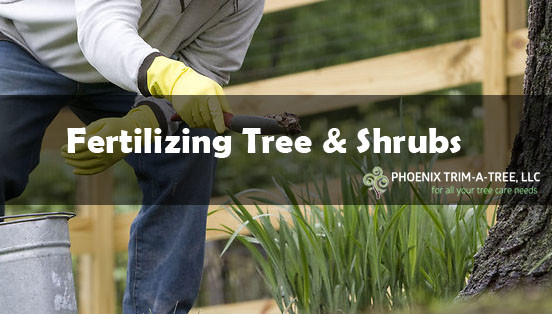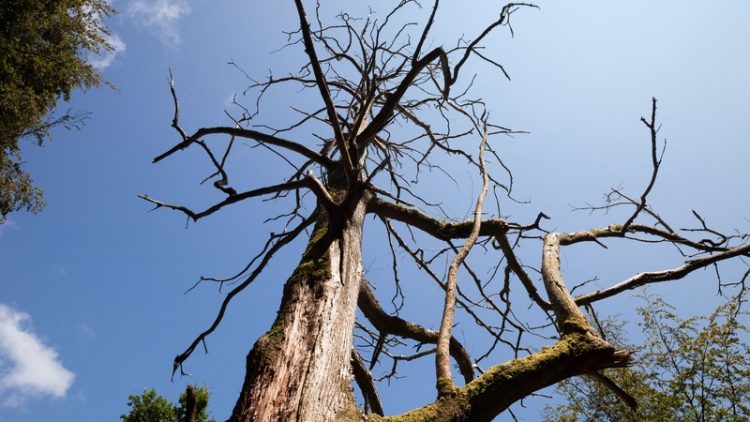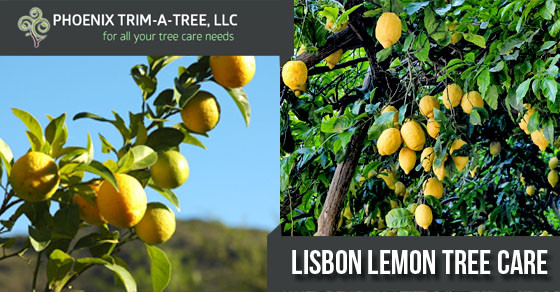Fertilizing Trees & Shrubs For Spring Arizona
FERTILIZING TREES & SHRUBS FOR SPRING ARIZONA
GET A FREE ESTIMATE TODAY!
Are you searching for “Fertilizing Trees & Shrubs” while looking for information about how to take care of your Phoenix valley landscape? Phoenix Trim-A-Tree knows how to take care of all of your tree and shrub needs in Valley of the Sun. To get the most healthy and beautiful trees and shrubs you need to know which kind of fertilizer to use for each type of plant, and how much to use. The way the fertilizer is applied is also critical for the it to be effective. In this article we help you understand the chemical elements needed for healthy plant diets, how to get the fertilizer to the roots, and when to apply your fertilizer.
TREES AND SHRUBS NEED NOURISHMENT JUST LIKE PEOPLE DO!
Large trees that are already well established don’t need as much nutrients as small shrubs and trees may. Also, feeding these smaller shrubs and trees can pay off big time if fed properly throughout there first couple years. Also, you will notice a return in the resistance to insects and disease, flowering improvements and quicker establishment than plants that weren’t properly fertilized. At Phoenix Trim A Tree, our shrub and tree care professionals will help you learn the art of proper fertilization. Here are a couple of fertilization tips for fertilizing trees and shrubs for the spring season in Arizona.
TIP #1 – PLANTS NEED A WELL BALANCED DIET
The primary nutrients your shrubs and trees need are potassium, iron, phosphorus and nitrogen.
- Nitrogen is great for encouraging fast branch and trunk growth, also producing of dark and healthy green leaves.
- Phosphorus is great for stimulating root growth(beneficial for recently planted shrubs and trees) Also promotes formation of flower buds and increases resistance to the cold.
- Potassium is great for making trees stronger, this helps them withstand high winds and protects them from diseases. Potassium makes the trees stronger, helping them to withstand wind and ice breakage as well as diseases.
- Iron is typically used in fertilizers to unlock other nutrients and make them more available to the plant. Iron is also used in some types of plants that are more prone to deficiencies.
TIP #2 – MAKE SURE YOUR ROOTS OF YOUR TREES CAN GAIN ACCESS TO THE FERTILIZER
Put the nutrients where the feeder roots can reach them. The main feeding area reaches from about a third of the distance from the drip line to the tree trunk. Fertilizer should be put into holes that are 6 to 12 inches deep throughout that area. For better distribution, you may need 10 feeding holes for every inch of truck throughout that area, (for example a tree that is 5 inches across will need 50 holes or more in the main feeding zone. Those holes ensure that fertilizer is evenly distributed and available to the tree.
TIP #3 – APPLY FERTILIZER TO THE SHRUBS AND TREES EARLY ENOUGH TO WITHSTAND HARSH WEATHER CONDITIONS
Trees are able to be fertilized between anytime in between fall, and mid July. Although, fertilizing trees in Arizona in July doesn’t have as much chance to harden and more susceptible to damage from cold temperatures. Early spring is the best feeding time but only use slow release materials to get the best results. Newly planted shrubs and trees benefits the most from fertilizer during their first five years of being planted. In growth, flowering and establishment, fertilizing your plants beats not fertilizing every time.
TIP #4 – FERTILIZING CITRUS TREES & OTHER FRUIT TREES
The Phoenix metropolitan area is one of the best locations in the country for growing citrus trees, along with other fruit bearing types of trees. With the warm weather and long growing season these trees add beauty to landscapes and provide welcomed fresh fruit to many residents. The best time to fertilize these trees is during late winter or the early spring months. For best year round results fertilizing these citrus and fruit trees should be started in the month of February. Specific fertilizers exist for these trees yet some residents choose to use a general shrub and tree food that ends up being a more cost effective solution. After fertilizing your trees and shrubs early in February keep an eye on their health. Signs to look for include the condition of roots and bark.
TIP #5 – FERTILIZING FLOWERING SHRUBS
Fertilization of your lilac and rose bushes should be done all year long with the exception of December and January. During these months they do not grow much and do not need the fertilizer. If you want to be the envy of your neighborhood with the best looking rose bushes and lilacs using tree and shrub food every month helps provide the necessary nutrients that local soils usually do not contain.
TIP #6 – FERTILIZING SHRUBS & HEDGES
Hedges and shrubs many times constitute the perimeter plants that outline our landscapes. They also line walkways to create a beautifully manicured yard. Having a very important role these online plants should not be forgotten in your landscape fertilization program. To help them get the best shape and healthiest look you should ensure that your hedges and shrubs get fertilized in February, again in the month of May, and then in September for the fall.
LAST THINGS TO REMEMBER WHEN FERTILIZING SHRUBS AND TREES
- Feeding plants during the first five years helps plants grow more quickly
- Balanced fertilization is key. Phosphorus, Nitrogen, Potassium and Iron each have their own functions in your landscaping
- Don’t fertilize your shrubs or trees between July and Fall, wait until after fall trees start resting period of dormancy
PHOENIX AREA TREE CARE
If you have trees that need to be fertilized, trimmed, pruned, or cared for we provide a full list of tree services in the Phoenix metro area. We help your trees look their best and stay strong so they are safe by removing dead branches, trimming to create the best shape, and enriching soil with everything your tree needs. Trees that aren’t watered or cared for properly pose a risk to your safety and the safety of your home. If you have dead trees on your property or trees that are sick call for professional help to save the tree or have dead trees removed. We remove trees quickly and safely before a strong storm removes the tree for you and potentially causes serious damage to your property or home.
HAVE QUESTIONS? CONTACT PHOENIX TRIM A TREE TODAY AT 480-962-0701.



